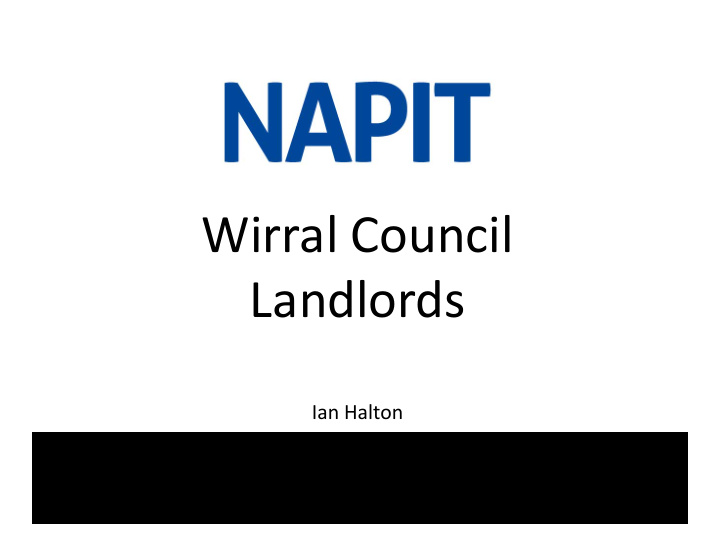



Wirral Council Landlords Ian Halton
Electrical Safety in the Private Rented Sector info@napitgroup.com www.napitgroup.com
Electrical Safety ‐ The Risk On average, more than 3,000 people each year are admitted to hospital as a result of an electric shock Around 10% of domestic fires in Great Britain were caused by electrical distribution systems (household wiring etc.) 16% of renters have experienced problems with electrical hazards in the past year, according to housing charity Shelter. info@napitgroup.com www.napitgroup.com
Electrical Safety ‐ The Law info@napit.org.uk www.napit.org.uk info@napitgroup.com www.napitgroup.com
Electrical Safety ‐ The Law The Law is very clear about what is required to confirm the electrical safety of a property in the HMO sector but there is no detail of how the electrical safety of a property should be demonstrated by landlords ‐ although it is clear the onus is on the landlord. This makes it difficult for landlords to understand the testing intervals that would be considered appropriate, and difficult for renters to ask for proof of the electrical safety standard of their home. Industry Position: An Electrical Installation Condition Report (EICR) carried out by a competent registered installer, should be carried out every 5 years, supported by a visual electrical checklist carried out annually or at change of tenancy ‐ whichever is sooner. This position has recently been adopted in Scotland. info@napit.org.uk www.napit.org.uk info@napitgroup.com www.napitgroup.com
What is an EICR? An Electrical Installation Condition Report (EICR) is a report carried out to • assess the condition of existing fixed wiring systems within a property e.g. consumer unit, protective bonding, lighting, switches and sockets etc. are fit for use Its purpose is to confirm, so far as is reasonably practicable, whether or not • the electrical installation is in a satisfactory condition for continued service. • An EICR only assesses the condition of the electrical installations at that time and recommends action for the property owner ‐ like a car MOT. info@napit.org.uk www.napit.org.uk info@napitgroup.com www.napitgroup.com
IET Guidance for I&T? info@napit.org.uk www.napit.org.uk info@napitgroup.com www.napitgroup.com
Understanding an EICR ‐ Classification Codes C1 – Danger present, risk of injury, immediate remedial action required C2 – Potentially Dangerous, urgent remedial action required C3 – Improvement recommended FI – Further investigation required C1, C2 & FI = Unsatisfactory C3 = Satisfactory info@napit.org.uk www.napit.org.uk info@napitgroup.com www.napitgroup.com
Photo’s from Landlord properties Things to look out for: Blanks, holes, cracks on a consumer unit • Signs of burning • Are the lights secure? • Are the sockets, switches, outlets all secure • Are there any signs of cracks/damage to all outlets? • Is there an earth on the property? • Is there protective bonding in place? • Is there an excessive use of multi way adaptors and extension leads? • Is there evidence of DIY electrical work? • Are all the Certificates available for all works and Building Regulations notifications • available for previous new works? Has the consumer unit got a next inspection, RCD test label and circuit chart? • info@napit.org.uk www.napit.org.uk info@napitgroup.com www.napitgroup.com
New Regulations – Jan 2016 info@napitgroup.com www.napitgroup.com
info@napitgroup.com www.napitgroup.com
Home Safety Guidance Documents info@napitgroup.com www.napitgroup.com
What is there purpose? Overall: Provide validation of the continued safety of the internal workings of privately rented properties Landlord: ‐ Allow landlords to best ensure that they have met their legal obligations in relation to potentially hazardous installations situations and appliances around the home ‐ give them a tool to demonstrate to potential tenants that they take their safety responsibilities seriously ‐ to reduce their own liability. Tenant: Provide peace of mind for tenants that the property they choose to live in is safe. info@napitgroup.com www.napitgroup.com
Home Safety Certificate Clear Legal Requirements Implied Legal Requirements info@napitgroup.com www.napitgroup.com
Recommended Home Safety Certificate info@napitgroup.com www.napitgroup.com
Home Safety Guidance Documents info@napitgroup.com www.napitgroup.com
Recommend
More recommend